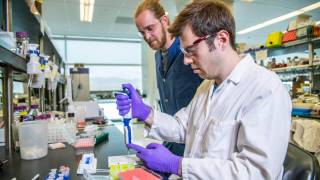Inflammatory Protein Might Protect Women From Spreading Herpes

Arizona researchers announced they have discovered a function in a pro-inflammatory protein that could play an important part in improving current and future therapeutics for the herpes virus.
This is an important study since about 260 million women worldwide are living with genital herpes and are transmitting it to new individuals daily.
The study at the University of Arizona College of Medicine-Phoenix, published on October 3, 2019, investigated whether the protein IL-36 is an essential component of the immune response to a herpes infection, or if other mechanisms can compensate for the lack of IL-36.
Cytokines, proteins essential to the immune system, coordinate the response to pathogens and allow for cell-to-cell communication. IL-36 is a pro-inflammatory cytokine identified 20 years ago.
Over the years, researchers have shown that it exhibits an important function in chronic inflammatory diseases, but only recently have scientists studied its role in infectious diseases such as herpes.
“We were the first group to detect IL-36 in the female reproductive tract and have been extending this work to evaluate the extent that this molecule can protect against, or contribute to, genital infection,” said Melissa Herbst-Kralovetz, Ph.D., senior and corresponding author of the study and associate professor in the Department of Basic Medical Sciences at the College of Medicine-Phoenix.
“Researchers have worked for decades to develop a vaccine to protect against genital herpes, but none has successfully passed through clinical trials,” Jameson Gardner, a graduate research student in the laboratory of Dr. Herbst-Kralovetz, said in an October 28, 2019, press release.
“These efforts have taught us so much about the immune response in the female reproductive tract, but the lack of success potentially indicates that we need to better understand important underlying immune mechanisms in the female reproductive tract as we seek to improve women’s health.”
After the initial genital herpes simplex virus 2 (HSV-2) infection in the vaginal epithelium, the virus spreads through the nervous system, where it establishes latency.
The herpes virus then goes into “hiding,” where it persists for a lifetime and periodically reactivates, causing lesions.
“We really were excited to see that after intravaginal HSV-2 infection, the virus was able to spread systemically throughout the nervous system and to the brain in those lacking IL-36g, whereas our control group, which had the gene intact, was significantly more protected against HSV-2 spread in the nervous system,” Gardner said.
“We’ve shown that IL-36 appears to function in a previously uncharacterized manner to protect against virus neuroinvasion (an infection that affects the nervous system).”
“We stumbled across this neuroinvasion finding and we were able to confirm that IL-36 is limiting the spread of the herpes virus from the genital tract to the nervous system,” Dr. Herbst-Kralovetz said.
The precise mechanism in which IL-36 protects against neuroinvasion is unknown but is an exciting and important area of future research.
In addition, researchers concluded IL-36 played a critical role in recruiting neutrophils, a type of white blood cell that protects against invading pathogens.
“Our understanding of how IL-36 functions can aid in the development of novel therapeutics to protect against – and hopefully decrease – the burden of STIs around the world,” Gardner said.
“The global disease burden of sexually transmitted infections is huge, and this work helps us to better understand the role IL-36 plays in the female reproductive tract and how that could impact women’s health in general.”
This research funding was supported by a National Institutes of Health grant: 1R15AI113457-01A1 (Herbst-Kralovetz). Other funding includes support by the Valley Research Partnership Grant P12 (Herbst-Kralovetz and Gardner).
Founded in 2007, the University of Arizona College of Medicine-Phoenix inspires and trains exemplary physicians, scientists, and leaders to optimize health and health care in Arizona and beyond. For more information, please visit College of Medicine-Phoenix.
Herpes News published by Precision Vaccinations
Our Trust Standards: Medical Advisory Committee


























